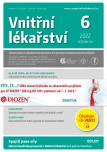Spontaneous coronary artery dissection, two case reports of men
Authors:
Adam Koudelka 1,3; Petr Lokaj 2,3; Jiří Pařenica 2,3; Jan Kaňovský 2,3; Petr Kala 2,3
Authors‘ workplace:
Klinika interní, geriatrie a praktického lékařství, Fakultní nemocnice Brno
1; Interní kardiologická klinika, Fakultní nemocnice Brno
2; Lékařská fakulta, Masarykova univerzita, Brno
3
Published in:
Vnitř Lék 2022; 68(6): 402-407
Category:
Case reports
doi:
https://doi.org/10.36290/vnl.2022.082
Overview
Spontaneous coronary dissection (SCAD) is one of the less common causes of acute coronary syndrome. It mainly affects younger patients without typical risk factors for ischemic heart disease. SCAD usually arises suddenly in otherwise healthy individuals with a previously full quality of life, and given the potential urgency of the condition, it is an important nosological unit in the differential diagnosis of chest pain. With the improving availability of comprehensive diagnostic methods we could see an increase in number of reported cases, and thus the potential for early intervention or active prevention of complications including malignant arrhythmias and cardiac arrest. It is therefore necessary to think about SCAD during examination of patients that are not yet at a cardiovascular risk. The vast majority of published case reports relate to cases described in women. Our article describes two case reports in men.
Keywords:
dual antiplatelet therapy – selective coronarography – spontaneous coronary dissection – type 2 myocardial infarction
Sources
1. Saw J, Mancini GB, Humphries KH. Contemporary review on spontaneous coronary artery dissection. J Am Coll Cardiol 2016;68 : 297-312.
2. Nishiguchi T, Tanaka A, Ozaki Y et al. Prevalence of spontaneous coronary artery dissection in patients with acute coronary syndrome. Eur Heart J Acute Cardiovasc Care 2016;5 : 263-270.
3. Saw J, Aymong E, Sedlak T, et al. Spontaneous coronary artery dissection: association with predisposing arteriopathies and precipitating stressors and cardiovascular outcomes. Circ Cardiovasc Interv 2014;7 : 645-655.
4. Thygesen K, Alpert JS, Jaffe AS, et al. ESC Scientific Document Group, Fourth universal definition of myocardial infarction (2018), Eur Heart J 2019; 40(3):241–251. Dostupné z https:// doi.org/10.1093/eurheartj/ehy462
5. Adlam D, Alfonso F, Maas A, Vrints Ch, Writing Committee, European Society of Cardiology, acute cardiovascular care association, SCAD study group: a position paper on spontaneous coronary artery dissection, Eur Heart J 2018; 39(36):3353-3368. Dostupné z https:// doi.org/10.1093/eurheartj/ehy080
6. Elkayam U, Jalnapurkar S, Barakkat MN et al. Pregnancy‑associated acute myocardial infarction: a review of contemporary experience in 150 cases between 2006 and 2011. Circulation 2014;129 : 695-702.
7. Tweet MS, Hayes SN, Codsi E, et al. Spontaneous coronary artery dissection associated with pregnancy. J Am Coll Cardiol 2017;70 : 426-435.
8. Fahmy P, Prakash R, Starovoytov A et al. Pre‑disposing and precipitating factors in men with spontaneous coronary artery dissection. JACC Cardiovasc Interv 2016; 9 : 866-868
9. Saw J, Humphries K, Aymong E, et al. Spontaneous coronary artery dissection: clinical outcomes and risk of recurrence. J Am Coll Cardiol 2017;70 : 1148-1158
10. Tweet MS, Gulati R, Williamson EE, et al. Multimodality imaging for spontaneous coronary artery dissection in women. JACC Cardiovasc Imaging 2016;9 : 436-450.
11. Ibanez B, James S, Agewall S et al. 2017 ESC Guidelines for the management of acute myocardial infarction in patients presenting with ST‑segment elevation. Eur Heart J 2018 : 39 (2);119-177. Dostupné z https://doi.org/10.1093/eurheartj/ehx393
12. McDonagh TA, Metra M, Adamo M et al. ESC Scientific Document Group, 2021 ESC Guidelines for the diagnosis and treatment of acute and chronic heart failure: Developed by the Task Force for the diagnosis and treatment of acute and chronic heart failure of the European Society of Cardiology (ESC) With the special contribution of the Heart Failure Association (HFA) of the ESC, Eur Heart J 2021;42(36):3629-3630. Dostupné z https://doi. org/10.1093/eurheartj/ehab368
Labels
Diabetology Endocrinology Internal medicineArticle was published in
Internal Medicine

2022 Issue 6
Most read in this issue
- Early gastric cancer
- Endoscopic treatment of early colorectal cancer
- Comprehensive approach to a patient with arterial hypertension and dyslipidemia
- Current trends in the diagnosis of pancreatic cancer
